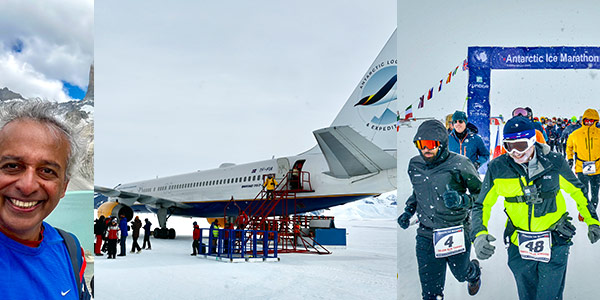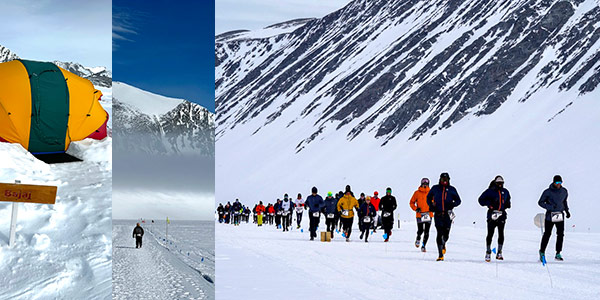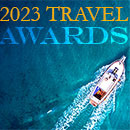|
ADVENTURE When minus 30C might be a perfect day for a runThe Antarctic Ice Marathon is not for everyone but for the few who do venture south for a nose-numbing experience, it is life changing. by Rahul Verghese 1 April 2024 SEE ALSO Goa resorts guide | Ladakh guide | Phuket Fun Guide | Zanskar Frozen River Trek | Hokkaido Fun Guide | Fun Asia holidays 
Torres Del Paine (left) is a spectacular Patagonian national park not far from Punta Arenas (Chile); The author in action at the Antarctic Ice Marathon (above); and warning signs on the blue ice runway on Union Glacier/ photos: Rahul Verghese, Antarctic Ice Marathon WHY would you ever want to travel deep into the Antarctic where there isn’t even any wildlife, and where the winds can hit 80mph and the temperature drops minus 30C to minus 60C? Perhaps it’s the lure of Shackleton, Amundsen, Scott and others who travelled there, some never to return. Or perhaps to climb Mt Vinson, the tallest peak on the Frozen Continent. Or to surround yourself by the silence and majesty of nature as you walk into timelessness. Or to understand the impact of climate change first-hand and see what we need to do to be ever more responsible as puny Earthlings. Or perhaps, to run a marathon there, as I did. Essentially, you need to be a little crazy to go this far off the beaten track and be driven by a deep passion. Whatever the combination of motivations, it is a life-changing experience that will certainly be remembered forever. You also get to experience ‘forever’ at 78 degrees S at Union Glacier in the Antarctic Continent. We landed on the blue ice runway on Union Glacier in a huge Airbus A350 and the 46 of us runners, coming in from Punta Arenas, were as excited as kids on their first ever Disney ride. Post a briefing at the camp and freshening up, we were at the start line of the marathon at 5pm for a dress rehearsal run on the first 2 km of the route and back, with our gear and bibs, to get acclimatised, figure out whether to shed layers, get used to running on the snow and ice — to see how the inconsistency of feet sinking in with each footfall would affect the manner of running — and to get the nerves right. The actual marathon was the next morning. I had come in from sunny Singapore with 50 hours of travel and layovers in Doha, Sao Paolo, Santiago, finally arriving in Punta Arenas in the Patagonian tip of Chile. There had been no opportunity to try out and get used to any of the gear I would be running with, other than the sunscreen lotion! The practice run on the final route was a relief as we were given the weather report of very light winds of under 10mph and mild temperature at around minus 10C. A huge relief. However, because that icy track was not quite firm and my feet would sink in around two to six inches in some parts, it was a bit tricky. I had to change the way I would run to make sure I didn’t fall. Runbuk, is the organising company of this Antarctic Ice Marathon, run by a crazy, adventurous Irishman – Richard Donavan — with logistics handled by Antarctic Logistics and Expeditions from Punta Arenas. The tents were cosy and surprisingly comfortable, with beds on which our super warm sleeping bags were laid out. The large mess tent in the camp was heated and with a huge spread of some of the most amazing food. December 14 was midsummer, which meant bright 24-hour daylight, so we were given eye masks to sleep with. 
Author (left) at Torres Del Paine; a marathon air lift as runners arrive at the blue ice runway atop Union Glacier 700 miles from the South Pole (above); The Antarctic Marathon gets underway (author in yellow jacket)/ photos: Rahul Verghese, Antarctic Ice Marathon Flag-off, on the 10.55km route was 9.30am. We would cover the circuit four times. After the first 15 minutes all 46 of us were well strung out. This was a marathon to discover yourself, nature, the vastness, solitude, and peace that nature had to offer, where many an explorer had perished enroute to the South Pole, just 700 miles away. My spiked Gore-Tex running shoes kept my feet warm and my waterproof stockings (which a South African friend from my Everest Marathon days had told me about) kept my feet dry from the melting ice that made its way inside my shoes. After the first lap which had some minor snow flurries and low visibility, the next lap saw the clouds beginning to lift over the horseshoe mountain range enclosing an edge of the vast Union Glacier. At times the clouds were like a translucent cover on the mountains. The third and fourth laps were truly amazing with the stark blue sky with a light dusting of clouds in the sky, and swathes of clouds around the mountains. I did not want this run to end as I ran the last loop with my SLR camera,. I had run the first three laps with my GoPro and iPhone. Back at the mess tent, post the run, we celebrated over another gorgeous meal under a bright sun at 12 midnight! Many of us had experienced an Antarctic shower where buckets of ice were heated to get warm water, to which we added ice for the right temperature — then using a pump to get the water to a shower nozzle. In all, this most amazing bath was completed with one bucket of water. That was a much talked about experience by all, as we realised the value of water, and what a luxury that bath was. All the camp waste would return with us on the flight, back to Punta Arenas. The camp itself is set up each year in the summer for three months for explorers, mountaineers, scientists and others, apart from the three days when it is occupied by avid marathoners. There are some flights from the Union Glacier which go to the emperor penguin colony (on the north coast) and to the South Pole depending on the weather, and with prior booking, mainly through Antarctic Logistics and Expeditions, who usually have tentative schedules and cut off dates for each. The costs ranged between US$1,000-$5,000 dollars for a day to a few days’ stay. When I returned to Punta Arenas apart from hitting a bar to watch Messi’s Argentinian team win the Soccer World Cup, I went into Torres Del Paine, which is a spectacular part of the best-known Patagonian National Park, a moderate four-hour hike up and a three-and-a-half-hour hike back to the base. There are nine day circuits as well as shorter trails that take three to four days. Several guided and unguided, and luxury to basic trips are available to be booked by a plethora of operators out of Punta Arenas and even more so from Puerto Natales, the gateway to the park – four hours by bus from Punta Arenas. 
Marathoners jog past a snowy massif (right); Participant checks the cleared route (centre left); and the bright tents, home for a few days/ photos: Rahul Verghese, Antarctic Ice Marathon Punta Arenas is on the Straits of Magellan, discovered by the man himself in 1519. There are excursions into a couple of whale sanctuaries and penguin colonies where sea lions and other marine life abound. These are definitely worth a couple of trips. Wildlife afficionados, bird watchers, photographers and travellers are all well rewarded in equal measure on these trips, which require warm clothing with wind and waterproof gear. Umbrellas are of no use because of the high winds and if you are carrying one, that is a dead giveaway that you are out on our first day in the area. The food is great, especially the seafood and the ‘Calafate Sour’ (a local drink with Calafate fruit). So, why would you want to go? Send us your Feedback / Letter to the Editor FAST FACTS / Hotels and GearFlights to the Antarctic, within the Antarctic, and gear rentals — Antarctic Logistics and Expeditions Getting to Punta Arenas: Getting to Union Glacier: South Pole and Emperor Penguin Colony: Getting to Torres Del Paine: Gear: Rental for the above is around US$250 for the period Get 2 sets of all this for you to carry to the Antarctic: For the Head: Ear protective balaclava; a really warm running cap; UV protective ski googles/ sun-glasses; ski mask for protecting the nose and mouth. For the Neck: Warm neck sleeve, muffler. For the Body: Sweat wicking inner; thermal middle layer and wind breaker outer shell for upper body and legs; Compression underwear and shorts. Hands and Feet: Nylon inner gloves with an outer Arctic glove; Inner nylon stocking with outer woolen and if possible waterproof stocking; Gaiters (as shoe covers); XC Running shoes – ideally warm / waterproof with Goretex, perhaps spikes and studs; One pair of regular running shoes. Others: 50SPF+ sun block lotion; Lip chap stick; light water bottle; Eye shades for sleeping in sunlight; Extra batteries for cameras and phones.
NOTE: Telephone and fax numbers, e-mails, website addresses, rates and other details may change or get dated. Please check with your dealer/agent/service-provider or directly with the parties concerned. SmartTravel Asia accepts no responsibility for any inadvertent inaccuracies in this article. Links to websites are provided for the viewer's convenience. SmartTravel Asia accepts no responsibility for content on linked websites or any viruses or malicious programs that may reside therein. Linked website content is neither vetted nor endorsed by SmartTravelAsia. Please read our Terms & Conditions. |



